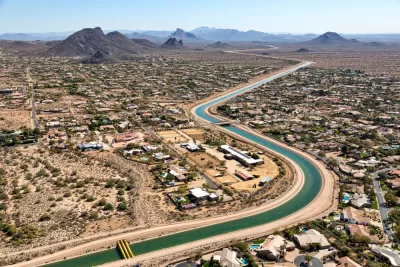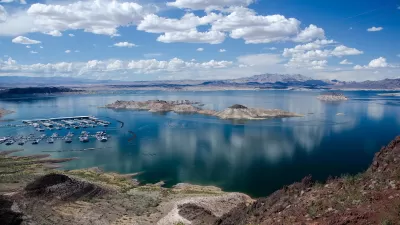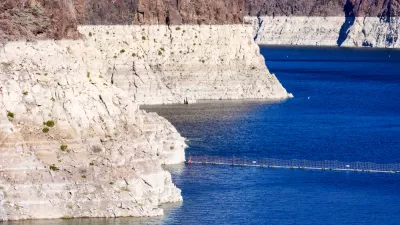Even as more people and companies flock to the state for its climate and economic opportunities, Arizona's water supplies are facing historic shortages.

"Arizona’s annual gross domestic product, nearing $380 billion, has more than doubled since 2000. New solar installations, electric vehicle makers, computer chip manufacturers, data centers, and corporate farming companies are piling into the state." Meanwhile, Phoenix is now the fifth largest city in the country. But as Keith Schneider writes, the state's booming growth is threatened by strained water supplies and dire projections for the future.
Climate change is disrupting the rules of the development game. Drought and extreme heat are emptying rivers and reservoirs, fallowing tens of thousands of acres of farmland, forcing thousands of homeowners to secure water from trucks and not their dead wells, and pushing Arizona ever closer to the precipice of peril.
The Colorado River, which provides over a third of the state's water supply, is 20 percent lower now than two decades ago. And, as we have covered in Planetizen previously, the two largest reservoirs in the country, Lake Mead and Lake Powell, both bordering Arizona, "now hold less water than at any time since soon after they were opened" at 30 percent capacity.
According to the article, the state is starting to take a harder look at ways to reduce its water usage and conserve for the future, but housing construction continues even as Arizona farmers face water shortages, some forced to reduce the amount of crops they grow.
FULL STORY: At Peak of Its Wealth and Influence, Arizona’s Desert Civilization Confronts A Reckoning Over Water

Alabama: Trump Terminates Settlements for Black Communities Harmed By Raw Sewage
Trump deemed the landmark civil rights agreement “illegal DEI and environmental justice policy.”

Planetizen Federal Action Tracker
A weekly monitor of how Trump’s orders and actions are impacting planners and planning in America.

Why Should We Subsidize Public Transportation?
Many public transit agencies face financial stress due to rising costs, declining fare revenue, and declining subsidies. Transit advocates must provide a strong business case for increasing public transit funding.

Understanding Road Diets
An explainer from Momentum highlights the advantages of reducing vehicle lanes in favor of more bike, transit, and pedestrian infrastructure.

New California Law Regulates Warehouse Pollution
A new law tightens building and emissions regulations for large distribution warehouses to mitigate air pollution and traffic in surrounding communities.

Phoenix Announces Opening Date for Light Rail Extension
The South Central extension will connect South Phoenix to downtown and other major hubs starting on June 7.
Urban Design for Planners 1: Software Tools
This six-course series explores essential urban design concepts using open source software and equips planners with the tools they need to participate fully in the urban design process.
Planning for Universal Design
Learn the tools for implementing Universal Design in planning regulations.
Caltrans
Smith Gee Studio
Institute for Housing and Urban Development Studies (IHS)
City of Grandview
Harvard GSD Executive Education
Toledo-Lucas County Plan Commissions
Salt Lake City
NYU Wagner Graduate School of Public Service





























